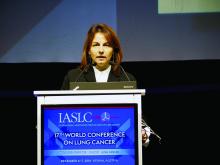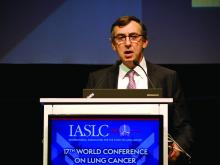VIENNA – In a heavily pretreated population of patients with non–small-cell lung cancer (NSCLC), the investigational checkpoint inhibitor durvalumab was associated with good objective response rates (ORR) and ‘impressive’ overall survival (OS) in a phase II study, Marina Garassino, MD, reported at the World Conference on Lung Cancer.
The primary endpoint of ORR in the open-label, single-arm ATLANTIC trial was achieved by 7% of patients with low (less than 25% of tumor cells) expression of the programmed death ligand 1 (PD-L1) that durvalumab targets (n = 93), by 16.4% of patients with PD-L1 expression of 25% or higher (n = 146), and by 30.9% in patients with PD-L1 expression of 90% or more (n = 68).
Patients who progress after two or more lines of chemotherapy have few treatment options and poor outcomes, said Dr. Garassino of Fondazione IRCCS Istituto Nazionale dei Tumori in Milan.Yet the results of ATLANTIC show not only that durvalumab is active, but also that it can produce long-lasting responses in patients who have been treated with a mean of three prior regimens, she reported.
The median duration of response to date was not reached in patients with PD-L1 expression of 25% or less, was 12.3 months in patients with greater than 25% PD-L1 expression, and had again not yet been reached in those with greater than 90% PD-L1 expression. At the time the data were pulled for analysis, June 2016, 18 of 21 patients in the latter group were progression free.
The disease control rate at 6 months was 20.4%, 28.8%, 38.2% for patients with PD-L1 expression of less than 25%, 25%-90%, and greater than 90%, respectively.
“One-year overall survival was about 48% in patients with PD-L1 greater than 25% and about 51% in those with PD-L1 greater than 90%,” Dr. Garassino said at the meeting, which was sponsored by the International Association for the Study of Lung Cancer.
The respective median OS times for patients with 25% and greater and less than 25% PD-L1 expression were 10.9 (95% CI 8.6-13.6) and 9.3 (95% CI 5.9-10.8) months, and not yet reached for patients with 90% or greater PD-L1 expression.
“Most adverse events were low grade and immune mediated adverse events were easily manageable,” Dr. Garassino said. Overall, 10.2% of patients had grade 3 or 4 treatment-related adverse events and 2.7% had treatment-related adverse events that led to discontinuation.
Any immune-mediated adverse event occurred in 12.3% of patients, of which 6.3% were due to an underactive and 2.4% to a hyperactive thyroid.
“Results are consistent with other anti-PD-1/PD-L1 compounds in metastatic, relapsed NSCLC and we are awaiting the final results of phase III trials to clarify the role of durvalumab [treatment] alone or in combination in NSCLC,” Dr. Garassino said.
Overall, 1,990 patients were screened for inclusion in the ATLANTIC study, which recruited 444 patients with stage IIIB-IV NSCLC who had received at least two prior systemic treatments, one of which had to be platinum based and had a recent (within 3 months) tumor biopsy and archived tissue available for PD-L1 assessment. Dr. Garassino reported results for two of the three cohorts.
Durvalumab was given at an intravenous dose of 10 mg/kg every 2 weeks for up to 1 year. The mean number of prior regimens was 3.2 for patients with less than 25% and greater than or equal to 25% PD-L1 expression combined and 2.6 for those with greater than 90% PD-L1 expression.
“This drug clearly does have activity and we can see that in the response rates, which range from 7% all the way up to 31%,” said Michael Boyer, MBBS, chief clinical officer of Chris O’Brien Lifehouse in Melbourne, who was the invited discussant for the trial. “The higher the PD-L1 expression, the higher the response rate,” he observed.
“There was quite impressive survival, if you bear in mind that this is a third-line, or more than third-line cohort of patients, with a median overall survival in the strongest PD-L1 expressing patients that is clearly going to exceed 1 year” he added.
The big question for the future is what will be the relevance of having an immunotherapy that works well in such a heavily pretreated population when these drugs are more likely to be used second- or even first-line, especially in those who have high PD-L1 expression where the drug seems to be at its most effective, Dr. Boyer said.
AstraZeneca funded the study. Dr. Garassino disclosed relationships with AstraZeneca, Bristol Myers Squibb, Roche, Merck, Sharp & Dohme, Boehringer Ingelheim, and Eli Lilly. Dr. Boyer disclosed that he had received research funding, honoraria, or both that were paid to his institution from Pfizer, Roche, Eli Lilly, Merck, Sharp & Dohme, Bristol Myers Squibb, AstraZeneca, and Clovis.



